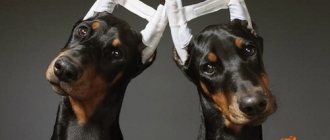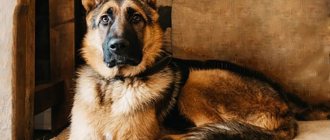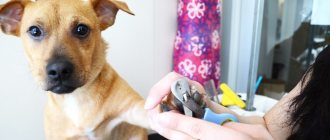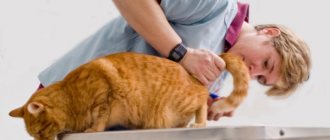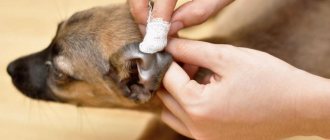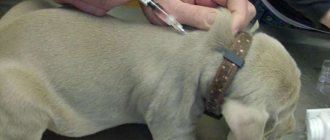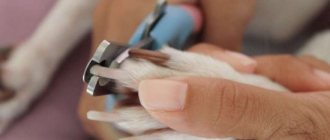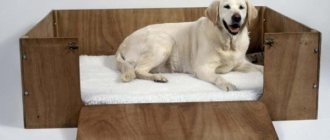A beautiful dog with even and straight ears is a real pride of the owner. Often, erect ears are considered the main sign of the breed of a tailed pet. However, they cannot always stand up on their own when they reach a certain age; they may remain hanging.
If the type of ears and their condition are not important to the owner, then he often does not pay attention to this defect, but what should those whose dogs take part in competitions and exhibitions do? In this case, you can try to install the ears yourself, but it’s still worth considering important features first.
Why should they be installed?
It is necessary to put ears on dogs so that the pet does not raise doubts about its elite status. Erect ears give animals a more aesthetic and impressive appearance. This issue is especially important for exhibition animals.
If the identified defect of lop ears is not a congenital defect and was not obtained as a result of injury, then simple manipulations will help correct the situation (in other cases, the help of a veterinarian and surgeon will be required).
Some dog owners do not consider ear studs necessary. Moreover, the standard of many breeds allows them both standing and hanging positions. In any case, the choice remains with the person, and the dog is completely indifferent to what ears it has, because this will not affect its devotion and love.
How to help your dog's ears stand up?
So, when your pet’s ears do not stand up before a certain period, the owner must act. You can install ears for your puppy using the following recommendations from experts:
- Strengthen the puppy's diet. Sufficient amounts of calcium should be present in his diet every day. These are cottage cheese and milk as its rich sources. Jellied meat in the form of boiled pig ears will replenish your dog's gelatin deficiency. You can simply buy ready-made vitamin and mineral complexes at a veterinary pharmacy to eliminate the problem of calcium deficiency. The veterinarian will tell you what kind of drug it should be.
- Massage. It is advisable to place the dog's ears four to five times a day and do a light massage up and down with your fingertips.
- Long walks, sufficient physical activity as a way to strengthen the immune system.
- Special devices. If the previous recommendations were not successful, then you can glue the puppy’s ears. To do this, they are first treated with alcohol for the purpose of degreasing and disinfection. The hair in the middle of the ear is cut, then each of them is carefully rolled vertically into a tube and glued with adhesive tape. This method is recommended for Yorkies. As for German shepherds, there are special inserts and stickers for them. It is usually recommended that dogs wear such artificial aids for at least two weeks. Then there is a break for two days. The procedure is done a second time. It may be necessary to conduct it a third time.
If you are concerned about such problems, then, first of all, you should consult with the owner of the nursery where the dog was purchased, and then with a veterinarian.
Why they don’t get up - reasons and solutions
Newborn puppies are born with small ears pressed to their heads. As the animal grows, they straighten out, the cartilage strengthens and they take on a vertical position.
The time has come, but the dog’s ears don’t stand up. Why? The answer to this question is often of great concern to owners. The process of ear raising is influenced by five main factors:
- Genetic inheritance.
- Unpurebred (mixed puppies).
- Lack of calcium in the body.
- Too thick (fleshy) ears.
- Thin and weakened.
The main thing is not to panic and not to give up. Problematic ears need human help and can be fixed. The set of activities includes:
- proper nutrition;
- special vitamins;
- manual massage;
- ear gluing.
Nutrition
If the puppy's diet does not have enough calcium, or he did not get enough of it through his mother's milk, his ears may droop. In this case, you need to review your pet's menu.
Small breed puppies born from bitches who have suffered from postpartum eclampsia (loss of calcium in the blood) will most likely have problems with ear placement!
You can add calcium to your dog’s body using natural goat’s milk or calcium-enriched cottage cheese. It is not difficult to prepare it at home.
Recipe for making calcined cottage cheese
Edible gelatin, which can be added to the puppy’s food or prepared aspic dishes based on it, will help your dog replenish the lack of calcium.
Excess calcium in a pet’s body is no less dangerous than its deficiency. In this regard, it is important to comply with the daily norm of its consumption.
Vitamins
To strengthen cartilage tissue, special vitamins should be added to the puppy’s main diet: Excel, Polydex, Canina, Beafarm, Calcefit, Volmar, Kanvit. Vitamin “Steed Plus” is good for lifting weak ears, but it is quite expensive and you can’t buy it in every store.
“Silver Trail” Calcium Peptide is a little-known Russian brand. Its natural composition and nano-method of supplying calcium to the bone and cartilage tissue of animals receive the highest marks from experts.
Before purchasing and using zoovitamins, you must consult a veterinarian.
Massage
Massage is an additional measure to solve the problem of drooping ears. It helps in combination with nutrition and vitamins. It is not difficult to do, and the dog perceives the massage as if it were affection.
During this time, the puppy should not be distracted and should be completely relaxed. Grasp the base of your baby's ear with your thumb and index finger. Using kneading massage movements, work the cartilage itself and move towards the tip, slightly pulling and directing the blade vertically. Perform several massage techniques at once in this way.
The massage will not harm the ears and the number of procedures during the day is unlimited . Thanks to it, blood flow increases in the tissues, which has a beneficial effect on the process of strengthening and maturation of cartilage tissue.
When do puppies' ears stand up?
Let us immediately note that the timing depends on the breed of the pet. For example, huskies and huskies develop ears relatively early: already at one and a half to two months. In Yorkshire Terriers, changes begin after three months. In German Shepherds - at 12–16 weeks. The permissible deviation in both directions is no more than 6 weeks.
Sometimes only one ear goes up; if there is still time left, this is not considered a cause for concern
I have a German Shepherd at home. Now she is already an adult, but once upon a time problems with her ears made us nervous. They rose at 3 months. We had already stopped worrying, since the ears stood confidently, like those of an adult dog. However, by 4 months they had fallen again. We went to the vet. He said this is a common occurrence with German Shepherds. This happens due to changing teeth. By 6–7 months, the ears rise again. The specialist told me to wait. He warned us to definitely come again if the situation does not return to normal by 7 months. After this age, it becomes difficult to correct the shape of the ears.
Bonding - pros and cons
The “gluing” method helps to radically make your puppy’s ears droop. It has proven itself in practice and is widely used for installing cropped and undocked ears on various breeds of dogs.
Some pets behave excitedly after gluing. They try to rip off the bandage and the structure with their paws, and rub their heads against the furniture. This way they can damage the ear cartilage and make the situation worse. In this case, you should loosen the tie and wrap or put on a special protective “collar” for the puppy.
Sometimes, after removing the adhesive plaster, an allergic reaction, pimples or scratches are clearly visible on the ears. Suitable for their treatment:
- baby powder;
- hydrogen peroxide;
- pharmacy blue.
After the ears have rested, the wounds have healed, and the crusts have dried, you will need to repeat the gluing procedure.
The “gluing” method is completely safe for the physiology of the animal and has no contraindications. This procedure should be carried out carefully, observing all preparatory and main steps.
Care instructions
It is preferable to use a hypoallergenic fabric patch. In second place are paper and silk bases.
If the puppy stubbornly removes the bandages, you need to make sure that he does not feel pain. Simple whims can be stopped with a restrictive collar.
If you are intolerant to the patch, it is better to purchase special glue from a veterinary pharmacy. It is used to glue the ends of the ear triangles, turning them outward.
Using different methods of ear placement will lead to even greater results if they are supplemented with useful advice from dog breeders who have already encountered a similar problem.
Regular analysis of the condition of the ears. Despite the recommended duration of the procedure (one course is about a week), it is better to remove the bandage every day, replacing it with a fresh one. The operation must be supplemented by examining the ears for redness, abrasions, and parasites.
Checking your Yorkie's ears
Use of additional restrictive means. Bandages on the ears cause discomfort to the animal - the puppy constantly tries to reach the tape to break it
A special therapeutic collar with a high collar, which somewhat hinders the movements of the head and front paws, can interfere with its actions. Important! Do not be alarmed if the bandage is torn in any place - its previous appearance can be easily restored by using a new piece of tape.
Materials for gluing. The least harm to the delicate skin on the ears will come from a hypoallergenic patch that can last on a dog for up to 5 days continuously. It can also be replaced with special animal glue, which is sold in veterinary stores and Yorkshire terrier nurseries.
It is enough to apply a thin strip of adhesive to the ear from the inside and squeeze it, gluing the sides together.
Artero ear fixation adhesive
Repellents. When there are several dogs in the house at once, it is difficult to keep track of the safety of the fixing bandage - relatives strive to constantly remove it, tear it or chew it off. Seasoning from ground pepper or garlic will help protect the retainer - you need to rub the tape over the entire area. Another option is treatment with a protective agent against bites and teeth (anti-rodents). It can be purchased at any veterinary store.
Ear cropping is an aesthetic plastic surgery, i.e. the use of plastic surgery methods to improve appearance
Apart from aesthetic pleasure, this service will not bring any benefit:
- Such dogs cannot participate in exhibitions, since the deviation was eliminated not naturally, but artificially.
- Such individuals are also not suitable for breeding Yorkshire terriers - the recessive trait is often inherited.
- The animal's health may be harmed during surgery.
It is worth remembering that the Yorkshire Terrier will become a loyal friend and a good family member, regardless of the shape and fit of his ears. Moreover, this small inaccuracy does not in any way affect the health of the pet.
Staging methods
Ear fitting for dogs is carried out using soft and hard structures. Both methods have the same goals and similar execution techniques, but differ from each other in the materials used.
Rigid design
The rigid design is used for large dog breeds and long cropped ears. You can make it yourself from scrap materials or buy it at a pet store. To create a basic hard “crown” you may find it useful:
- foam rollers for the liner;
- medical glue will help to glue the curlers;
- a pencil so as not to get your hands dirty;
- Popsicle sticks for rigidity and as a guide line;
- General fixation will require medical or surgical tape. Reinforced construction tape or masking tape will also work.
Make sure that the glue does not get into the animal’s ear canals and do not forget to first remove hair from the ears and degrease them with an alcohol solution.
Soft design
This setting option is suitable for small breed puppies. It provides for gentle gluing without glue or complex rigid fixations. Making gluing using a soft structure is not difficult.
The necessary materials are a 3 cm wide adhesive plaster and cotton swabs (for rigidity). As in the first case, the fur from the ears must be shaved off and the ears wiped with alcohol, otherwise the procedure for removing the adhesive tape will cause pain to the puppy.
There are many options for gluing and setting ears. Any materials can be used: sanitary tampons, cut-outs from plastic cards, pen refills, plastic bottles and foam sponges.
The main rule is do no harm. It is important that the devices do not injure the puppy, are durable and light, so that they are easy to install and not difficult to remove.
Breeders' advice
In order not to damage the puppy’s sensitive ears or disrupt the process of natural raising of the shells, you must follow the principles recommended by experienced breeders:
Timeliness. After studying the information about what time a Yorkie’s ears should become stronger and stand up, it becomes clear that mechanical methods of installation can be started after 4 months. Reliability. If the dog tries to tear off the structure that secures the ears, you need to use a high collar that limits access to the top of the head. If there are other pets in the house, the sinks should be treated with a special Anti-Gryzin solution. It has a pungent odor and contains pepper.
The product must be applied with caution. Regularity. Changing garters in a timely manner will allow you to observe the process of lifting cartilage and help you notice the result in time. Control. If the structure is damaged, it is not necessary to completely redo it
It is enough to glue the winding with an additional piece of plaster. Hypoallergenic. Pasting is done only with hypoallergenic materials; the use of electrical tape is not allowed.
If the structure is damaged, it is not necessary to completely redo it. It is enough to glue the winding with an additional piece of plaster. Hypoallergenic. Pasting is done only with hypoallergenic materials; the use of electrical tape is not allowed.
The Yorkshire Terrier is a cute pet, capable of giving a lot of positive emotions, and a loyal friend. Any Yorkie owner wants his pet to be healthy, cheerful and cheerful. Attentive owners surround their dogs with care and love and carefully monitor their appearance.
Creative care for your pet's appearance
But as with other decorative breeds, Yorkshire terriers have their own characteristics and possible defects. Most often, a problem arises with the straightening of the ear cartilages.
Before wondering how to properly position the ears of a Yorkshire Terrier, it is recommended that you study the information above. Having figured out when a Yorkie's ears stand up naturally, it becomes clear in which cases feeding can be done and whether additional external fixation is needed.
Step-by-step instructions for installing undocked ears on small dog breeds
All small and decorative breeds have the same way of setting problematic, undocked ears. Let's consider it using the example of the Chinese Crested Dog, whose ears can be set on the 21st day of life. To do this you will need:
At the base of the auricle there is a delicate septum. Work carefully, ask another family member to help you, fix the pet's head . The noise and vibration of the machine can frighten him.
- Shave the hair on both sides of the ears with a trimmer. This will reduce their severity and ensure painless removal of the adhesive plaster. Remove any remaining fur from the edges with scissors.
- Wipe the ear with alcohol or any degreaser to make the patch stick better.
- Cut a piece from the adhesive plaster that is the length of the ear and place it on the table with the adhesive side down.
- Cut half a cotton swab and place it on the adhesive plaster.
- Place the second and third layers of adhesive tape on top of the cotton swab.
- We cut out the resulting strong sizing according to the shape of the ear, with the cotton wool facing down, and glue it to the inside of the ear, so that the ear canal is visible.
- We wrap the ears like a tube, but not too tightly so that the animal is comfortable.
- We wrap the folded ear at the base of the cartilage around the circumference with adhesive tape. Do not bring your ears close to the top of your head, as this may cause them to be positioned incorrectly. The bandage should look natural.
- To prevent the ears from falling apart in different directions and leaning forward, they will need to be fixed horizontally. They need to be connected to each other so that they are vertical. We connect them with adhesive tape at the base.
The puppy needs to stay in this bandage for about 5 days. Then the patch is removed, carefully unwinding it and trimming the hairs of the fur with scissors. It happens that after the first gluing procedure the ears already stand up.
If the result of raising was not achieved, then after a 12-hour rest the ears are glued again in the same way until they become stronger and take a vertical position..
The Chinese Crested Dog has two varieties: hairless and powder coated. The ear placement pattern is the same for both. According to the standard, the hairless variety must have erect ears, while the puffer variety is allowed to have both erect and hanging ears. According to breeders, a puff with erect ears looks more impressive.
Why don't my puppy's ears go up?
The following factors can slow down or stop the process:
- the pet is not purebred;
- large puppy size;
- weakened immune system;
- period of teeth change;
- stress;
- mineral deficiency.
Even if you bought a puppy with erect ears, they may fall off when moving home. The reason is fear. In an unfamiliar environment, the baby behaves warily. Usually the situation returns to normal after a few weeks.
Why does a shepherd dog have such ears?
The deep and voluminous auricle of the German Shepherd is a moving locator that sensitively picks up sound at a frequency of more than 30,000 Hz and at a distance much greater than a person can hear.
Since the range of frequencies a dog can hear is much higher than that of a person, the German Shepherd determines the source of the sound and its direction and distance instantly and accurately thanks to such an auricle at a distance of 25-50 m (depending on the pitch of the sound). And a shepherd dog can detect the sound of thunder or the sound of a running chainsaw at a distance of 9-12 km!
For comparison. The lowest sound for a person is 16 Hz, the highest is 20 thousand Hz. The upper limit of frequency fluctuations perceived by a shepherd dog as sound will be 80-100 thousand Hz.
Delicate hearing is especially important for the German Shepherd, as for a dog with high service qualities and no less high requirements for its work.
Sensitive ears allow you not only to rely on the shepherd as an excellent watchman, but also to guide it from a great distance, giving commands at frequencies that are not perceived by the human ear or in a low voice.
We glue our ears correctly!
How long should I start the gluing procedure? Until 8-10 months, cartilage correction is unlikely to be needed; most likely, support in the form of massage and, possibly, gartering of two ears together from 3-4 months of age so that they take the correct position on the head.
Details in the video: “How to properly position the ears of a German Shepherd puppy.”
How to determine whether correction is needed?
Feel your ear from base to tip. If you find a thinned area or “liquid” tissue, then look to see if there is a convex scar in this place, along the length of which the ear folds. If a crease or scar is found, it needs to be glued urgently!
How to do this correctly is well shown in the video “Putting ears on a shepherd dog. 2 ways." In addition to 2 methods of gluing broken ears, the video gives a lot of valuable advice to a novice sheepdog owner.
"Anatomy" of the ear
All sheep dogs are born blind and deaf - imperfect.
Their small ears are also imperfect - they are soft due to the imperfect cartilage that makes up the auricle. The soft, weak cartilage grows, strengthens and increases in size along with the puppy, turning into an elastic cartilage plate that lacks blood vessels.
The cartilage plate is covered on both sides with a layer of thin connective tissue that provides growth and nutrition to the main cartilage - the perichondrium. The perichondrium, on the contrary, is literally dotted with mini-hematopoietic capillaries and blood vessels, through which the cartilage receives the necessary substances for its growth and compaction using the method of ordinary diffusion (penetration upon contact).
A puppy cannot be confidently classified as a purebred puppy until its ears stand up.
Using the same method, the shepherd's ear cartilage is built up - the perichondrium has semi-stem cells, which, like bricks, are built into the cartilage tissue.
The puppy's ears do not stand up until the perichondrium completes the main cartilage to the required density!
Cartilage cells, in turn, produce collagen and elastin, on which the strength of the shepherd's auricle depends - the density of the cartilage increases due to the addition of new layers on both sides of the perichondrium.
Small German Shepherd puppies have ears that appear too large for their heads. This is due to the active work of all parts of the auricle (cartilage and perichondrium). From 2 to 4 months, active collagen production occurs, the ear actively increases in size, becoming, as it were, “growing.” The scheme of superstructure, increasing the growth and strength of the cartilage works throughout the first period of the puppy’s growth, when its size increases significantly, but the ears still remain drooping.
Puppy ears look disproportionately large
Up to 4 months, cartilage tissues behave especially actively, but by 5 months the growth of elastic layers and the integration of stem cells decreases, and, having reached a certain density, the growth of the ear slows down, so that in a short time it almost disappears.
The metabolism in the auricle becomes so low that visually the ear seems to no longer grow, however, limited living processes in it continue throughout life, otherwise it would be impossible to restore the tissues of the shepherd's ear if damaged.
What is necessary for the proper formation of the cartilage plate and the development of the perichondrium?
First of all, it is necessary to provide the cells of cartilage tissue with nutrition so that they can “build”. To do this, you need to feed the puppy a balanced diet with sufficient amounts of calcium and phosphorus.
Attention! Mineral supplements with a high content of these substances are categorically not recommended for independent use if you want to quickly give your shepherd ears!
Excess calcium and phosphorus can negatively affect the formation of ear cartilage and the development of the musculoskeletal system of the German Shepherd.
We must not forget about the composition of the blood - it is the main nutrition for the growth and strengthening of the cartilage plate, through diffuse contact with it through the perichondrium.
Not only nutrition, but also the obligatory physical activity of a German Shepherd puppy, both at home and on walks, will help improve the blood supply to the perichondrium.
Under such conditions of detention, the shepherd’s ears stand up on time and no additional actions are required on the part of the owner.
